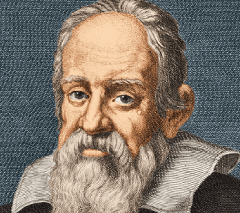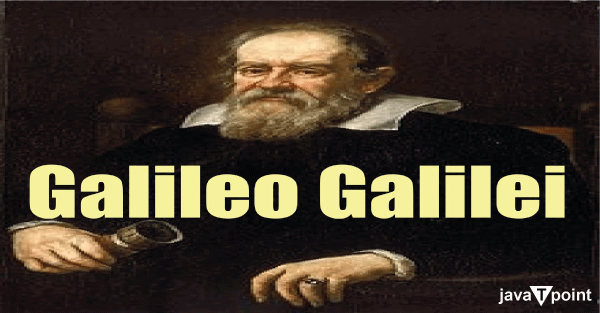Galileo Galilei

Galileo Galilei, born on February 15, 1564, in Pisa, Italy, emerged as a towering figure in natural philosophy, astronomy, and mathematics. His profound contributions have left an enduring imprint on the scientific landscape, fundamentally altering our understanding of motion, astronomy, and the scientific method. Galileo's trailblazing formulations concerning circular inertia, the law of falling bodies, and parabolic trajectories marked a paradigm shift in the study of motion.
Additionally, his unwavering belief in the mathematical language of nature reshaped the discourse from qualitative narratives to quantitative exploration. This biographical exploration delves into the chronicles of Galileo's life, illuminating his transition from a precocious mind in Pisa to a visionary who revolutionized our perception of the cosmos.
Early Life and Career
Galileo's roots trace back to Pisa, Tuscany, where he was born as the eldest child of Vincenzo Galilei, a notable musician known for his contributions to music theory. The family's migration to Florence in the 1570s established a foundation in a city that would deeply influence their trajectory. Galileo's educational journey led him to the monastery school at Vallombrosa, followed by admission to the University of Pisa in 1581, with an initial inclination toward medical studies. Yet, the allure of mathematics ignited a fervor that would steer him toward an extraordinary path, defying conventional expectations.
By 1585, Galileo's departure from the university without a degree did not waver his passion for mathematics. He ventured into Florence and Siena, offering private tutorials and crafting innovative theorems, gradually earning him recognition. A revolutionary invention took shape in his hands?a hydrostatic balance?that augmented precision in measurement. This period also bore witness to his manuscript treatise "La pancetta," which gained circulation among intellectual circles. Galileo's inquisitiveness led him to investigate motion, marking a shift away from Aristotelian concepts.
1588 Galileo's pursuit of academic positions led him to apply for a mathematics chair at the University of Bologna, although his application could have been more fruitful. Nevertheless, his stature was on the ascent, culminating in invitations to lecture at the prestigious Florentine Academy.
During this phase, Galileo proffered insightful theories on centers of gravity and secured the patronage of Guidobaldo del Monte, a respected nobleman. 1589 heralded a significant milestone as Galileo secured the chair of mathematics at the University of Pisa. Here, he demonstrated, in dramatic fashion atop the Leaning Tower, that the speed of descent is unaffected by the object's weight?a radical departure from Aristotelian tenets.
Telescopic Discoveries of Galileo
Galileo's trajectory, however, underwent a profound transformation in 1609. News reached him of a Dutch invention that brought distant objects close, setting him on a path of astronomical exploration. Galileo birthed a series of telescopes by reverse engineering and refining the instrument, leading to transformative discoveries.
In this period, he unveiled the Moon's phases and the presence of four moons orbiting Jupiter?revolutionary insights that unsettled prevailing cosmological paradigms. This groundbreaking work culminated in the publication of "Sidereus Nuncius" (The Sidereal Messenger), solidifying his reputation and paving the way for appointments, including mathematician and philosopher for the grand duke of Tuscany.
Galileo ventured deeper into a realm that challenged Aristotelian cosmology as he observed Saturn's puzzling appearance and Venus's phases. While these discoveries did not establish the Copernican heliocentric model definitively, they destabilized entrenched notions, fostering his conviction that Earth orbited the Sun. This conviction signaled a pivotal moment in the unfolding scientific revolution.
- Pioneering New Realms of Understanding
Galileo Galilei's scientific expedition is a testament to ceaseless curiosity, visionary thought, and an unswerving dedication to pushing the frontiers of human comprehension. Galileo's scientific trajectory encapsulates a legacy that has profoundly molded the trajectory of human knowledge from his pioneering voyages into motion and mechanics to his trailblazing astronomical observations.
- Unveiling Motion's Foundations
Galileo's scientific odyssey ignited an insatiable fascination for the intricate laws underpinning motion. His experiments involving falling bodies challenged the prevailing norms, unraveling the revelation that the mass of an object doesn't influence its descent speed?a paradigm shift from Aristotle's teachings.
This discovery laid the bedrock for contemporary mechanics and sowed the seeds for Isaac Newton's seminal laws of motion. Galileo's meticulous observations and innovative experimental methodologies led to a fresh era of empirical exploration.
- Astronomy: Illuminating Celestial Enigma
Galileo's astronomical contributions heralded a turning point in humanity's cosmic perception. Equipped with a telescope, he embarked on a celestial odyssey that would disrupt prevailing paradigms.
His meticulous scrutiny of the Moon's cratered terrain and discovery of Jupiter's moons unveiled a universe steeped in intricacy and dynamism. These revelations challenged the geocentric model, prompting a reevaluation of established principles and a resounding affirmation of the heliocentric doctrine proposed by Copernicus.
- The Art of Scientific Methodology
Galileo's unwavering belief in empirical exploration and the potency of the scientific method underscored his approach. He contended that the verities of nature were inscribed in the language of mathematics, thus emphasizing the importance of precise observation, meticulous measurement, and rigorous analysis.
His unwavering advocacy for methodical experimentation and the pursuit of conclusions grounded in evidence laid the cornerstone for the contemporary scientific process, sparking generations to engage in inquiry with meticulous exactitude.
- Confronting Authority: Trials and Triumphs
Galileo's revolutionary notions often intersected with his era's prevailing religious and philosophical doctrines. His steadfast support for the heliocentric perspective?placing the Sun at the solar system's heart?catapulted him into confrontation with the church's geocentric stance.
His masterpiece "Dialogue Concerning the Two Chief World Systems" ignited a fervent debate, culminating in his condemnation by the Roman Catholic Church. Despite these adversities, Galileo's commitment to unveiling truth remained resolute.
- Legacy and Reverberations
Galileo Galilei's scientific voyage resounds through the corridors of history. His contributions to mechanics, astronomy, and scientific methodology laid the cornerstone for the scientific revolution that reshaped humanity's intellectual landscape.
His notions served as a catalytic force for successive generations of scientists, encouraging them to question established norms and plunge into the universe with an insatiable yearning for knowledge. Galileo's odyssey encapsulates the essence of intellectual audacity, ingenuity, and the relentless pursuit of truth?a legacy illuminating the uncharted expanse of discovery.

Galileo's Profound Impact on Modern Physics
- Shaping the Landscape of Discovery
Galileo Galilei's indelible mark on modern physics reverberates with transformative force, ushering in a new era of understanding that resonates through the corridors of time. His groundbreaking contributions laid the groundwork for classical mechanics and sowed the seeds of profound change that would sculpt the essence of modern physics.
- The Forefather of Classical Mechanics
Galileo's pioneering exploration into motion and mechanics acted as a precursor to the monumental laws of motion formulated by Isaac Newton. Through methodical experimentation with falling bodies and his revolutionary concept of inertia, Galileo uncovered the essence of objects in motion without the influence of external forces. His revolutionary insight that the velocity of descent remains independent of the object's mass marked a pivotal divergence from Aristotle's teachings, paving the path for Newton's epochal laws.
- Astronomical Revolution
Galileo's telescopic revelations heralded a celestial renaissance, forever altering humanity's perception of the cosmos. His meticulous examination of the Moon unveiled a rugged terrain, dispelling the notion of a perfect, unblemished celestial sphere.
The revelation of Jupiter's four orbiting moons shattered the confines of the geocentric model, painting a picture of a dynamic planetary system with multiple centers of motion. These epochal discoveries fortified the heliocentric model proposed by Copernicus, fanning the flames of a paradigm shift that echoed through modern celestial mechanics.
- Championing Empirical Inquiry
Galileo's relentless advocacy for empirical investigation and adherence to the scientific method laid the bedrock for modern physics. Galileo set the tone for generations of physicists with an unwavering conviction that nature's manuscript is written in the language of mathematics and that experimentation is the interpretive key. His emphasis on systematic observation, meticulous measurement, and mathematical analysis paved the trajectory for the scientific community's leap into a new age of exploration.
- Galilean Invariance and Relativity
Galileo's seminal work on motion and reference frames sculpted the principle of Galilean invariance?a cornerstone in classical and modern physics. This foundational principle postulates the universality of mechanics across uniformly moving reference frames, casting a blueprint for Albert Einstein's groundbreaking theory of special relativity. Einstein's revolutionary insights expanded and refined Galileo's ideas, unmasking the intricate relationship between space, time, and the speed of light.
- Wave-Particle Duality and Quantum Insights
Galileo's resolute devotion to empirical exploration resonates even within the enigmatic realm of quantum mechanics. His unwavering commitment to challenging status quo assumptions finds resonance in the intricate concept of wave-particle duality?a proposition that particles exhibit dual characteristics of both waves and particles. This cornerstone of quantum physics, challenging classical paradigms, echoes the essence of Galileo's intellectual tenacity.
- Culmination: A Guiding Light for Progress
The imprint of Galileo Galilei on modern physics remains deeply profound. His empirical ethos, mathematical genius, and paradigm-shifting revelations have paved an illuminated path for scientific inquiry. From classical mechanics to the frontiers of relativity, from the cosmos to the microcosm of quantum mechanics, his legacy endures as a guiding star, illuminating progress in modern physics.
Galileo's inquisitive spirit and his steadfast quest to unveil the universe's mysteries continue to inspire physicists and scholars globally, a living testament to the enduring vigor of human exploration.
Conclusion
Galileo Galilei's life journey unfolds as a narrative of exploration, innovation, and unwavering belief. From his formative years in Pisa to his groundbreaking telescopic revelations and his embrace of the Copernican perspective, Galileo's trajectory embodies relentless inquiry that confronted established norms and reframed humanity's comprehension of the universe. This biographical odyssey delves into the tapestry of a visionary who forever changed the course of scientific history.
|


 For Videos Join Our Youtube Channel: Join Now
For Videos Join Our Youtube Channel: Join Now









